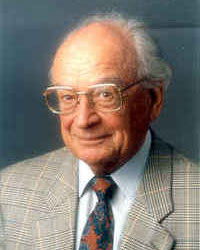
Photographer Unknown
Erowid Character Vaults
Hanscarl Leuner
Jan 1918 - Jun 22, 1996
Summary
Hanscarl Leuner studied medicine at Frankfurt University and Marburg University (1939-1946), interrupted by his military service in World War II. Through his studies of psychotherapeutic practices, he developed a special interests in guided mental imagery, "catathymic influences" (the interaction of mental contents and emotional processes), dreams and daydreams. He developed a standardized treatment technique based on this research called Guided Affective Imagery. In 1955, Leuner introduced the use of low doses of LSD into his developing practice. Over the next five years, he conducted more than 1,300 individual sessions with different hallucinogens (LSD, mescaline, psilocybin, atropine derivatives, etc.) with neurotic patients and normal volunteers.
In 1960 Leuner transferred to Göttingen University where he established a psychotherapy department. That year, impressed by the therapeutic possibilities of hallucinogen-assisted psychotherapy, Leuner initiated the First European Symposium on Psychotherapy with LSD-25 attended by experienced colleagues from around Europe. The next European symposium, Hallucinogenic Drugs and Their Psychotherapeutic Use, was initiated by the British Royal Medico-psychological Association in London in 1961. After this meeting, Leuner tried to organize interested psychotherapists in the European Medical Society of Psycholytic Therapy (EPT) which was founded in 1964.
In 1965, when the nonmedical use of psychedelics reached its first peak, Leuner was invited by the National Institute of Mental Health (NIMH) to do expert evaluations on the few remaining American research projects involving hallucinogens. In the wake of increasing restrictions on psychedelics, the EPT was dissolved after its fifth symposium in 1971, and Leuner began focusing his energies on propogating non-pharmacological therapies. Nevertheless, Leuner retained his license and continued doing psycholytic work until his retirement in 1986. In 1985, together with other important researchers in the field, Leuner founded the European College for the Study of Consciousness (ECSC) and acted as its president. His meticulous studies into the efficacy of psycholytic therapy and the introduction of the short-acting substances CZ-74 (4-hydroxy-diethyltryptamine, a psilocybin derivative) and LE-25 (2,5-dimethoxy-4-methylphenethylamine, or 2C-D) into therapeutic practice position him as an important pioneer of the medicinal use of psychedelics.
In 1960 Leuner transferred to Göttingen University where he established a psychotherapy department. That year, impressed by the therapeutic possibilities of hallucinogen-assisted psychotherapy, Leuner initiated the First European Symposium on Psychotherapy with LSD-25 attended by experienced colleagues from around Europe. The next European symposium, Hallucinogenic Drugs and Their Psychotherapeutic Use, was initiated by the British Royal Medico-psychological Association in London in 1961. After this meeting, Leuner tried to organize interested psychotherapists in the European Medical Society of Psycholytic Therapy (EPT) which was founded in 1964.
In 1965, when the nonmedical use of psychedelics reached its first peak, Leuner was invited by the National Institute of Mental Health (NIMH) to do expert evaluations on the few remaining American research projects involving hallucinogens. In the wake of increasing restrictions on psychedelics, the EPT was dissolved after its fifth symposium in 1971, and Leuner began focusing his energies on propogating non-pharmacological therapies. Nevertheless, Leuner retained his license and continued doing psycholytic work until his retirement in 1986. In 1985, together with other important researchers in the field, Leuner founded the European College for the Study of Consciousness (ECSC) and acted as its president. His meticulous studies into the efficacy of psycholytic therapy and the introduction of the short-acting substances CZ-74 (4-hydroxy-diethyltryptamine, a psilocybin derivative) and LE-25 (2,5-dimethoxy-4-methylphenethylamine, or 2C-D) into therapeutic practice position him as an important pioneer of the medicinal use of psychedelics.
Author of (Books)
Author of (Articles)
Writings & Info

